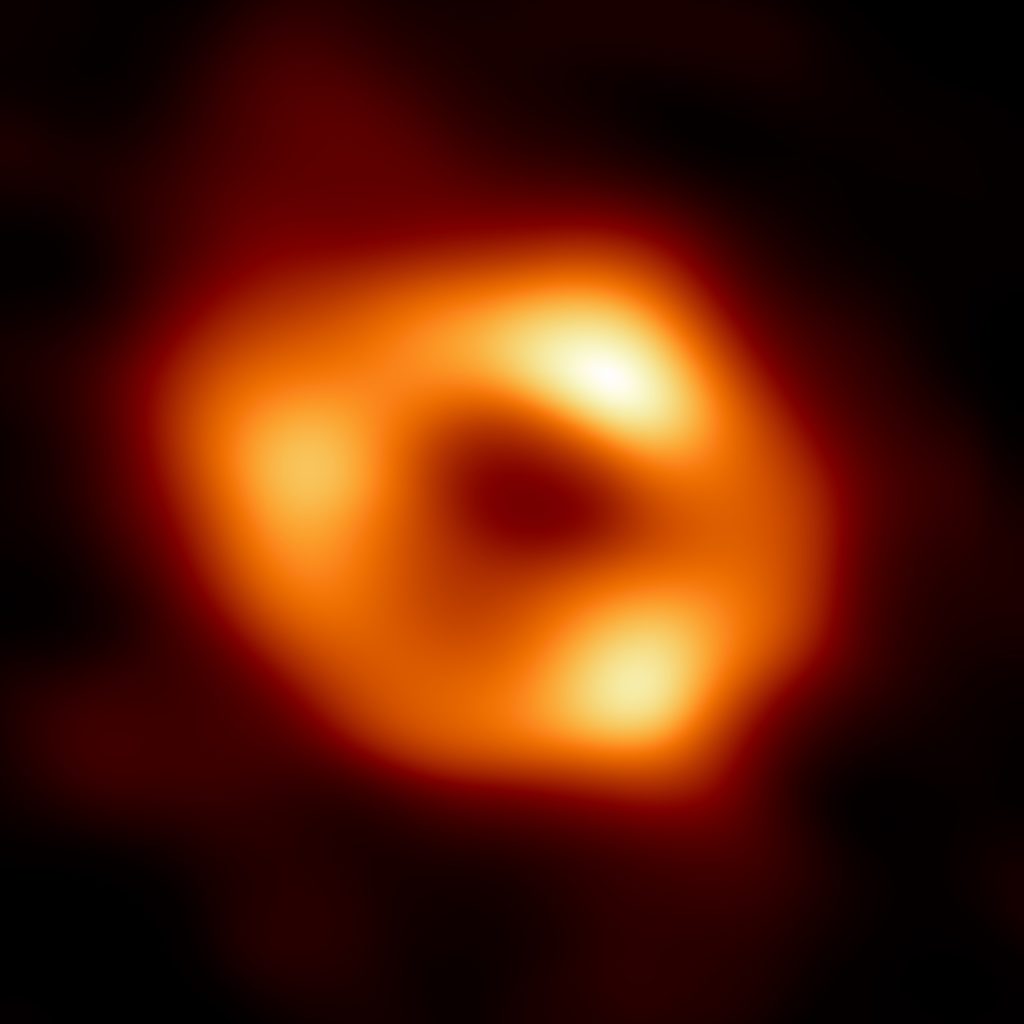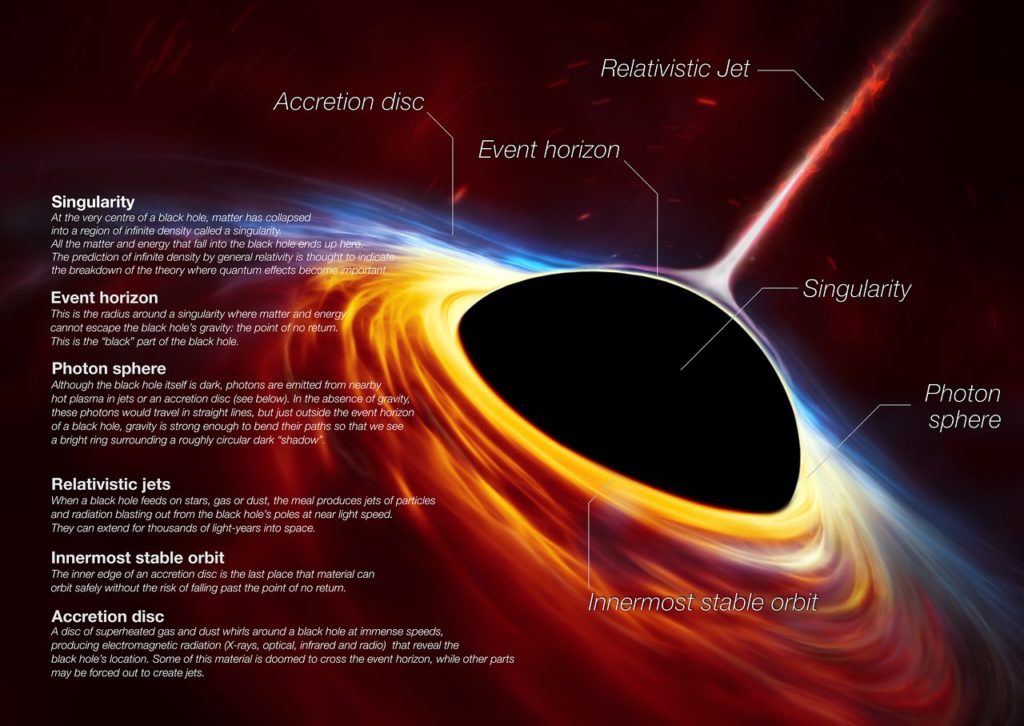[“Our Milky Way” series]

Years in the works. The announcement had been anticipated for awhile. The big news was released today: First image of Black Hole at the center of our galaxy. Heart of the Milky Way, eh.
This is about more than synthesizing an image from photos taken by “telescopes on high mountaintops” positioned around our planet. This is about computational imaging – constructing an image from sparse, noisy, incomplete data from radio (vs. optical) telescopes [1]. An image which accurately (likely) fits the data. At a reasonable level of confidence.
• Caltech > News > “Caltech Researchers Help Generate First Image of Black Hole at the Center of Our Galaxy” by Robert Perkins (May 12, 2022) – A historical image, the product of technically challenging telescope observations and innovative data processing that tackles the unique complexities in EHT data.
“Through literally years of exhaustive tests on both real and synthetic data we are now confident that there is compelling evidence that the true underlying source has a ring structure,” Bouman [Katie Bouman, assistant professor of computing and mathematical sciences, electrical engineering and astronomy] says.
How to resolve sparse, noisy, incomplete data? Build a model.
To reconstruct an image, the EHT team developed computational imaging algorithms capable of making inferences to fill in the blanks in the data that had been gathered. The team discovered that multiple ring geometries could explain the Sgr A* data, as well as some geometries that do not look ring-like at all. To better understand how the imaging algorithms worked on data from an evolving target, Levis built a synthetic model of variable structure (akin to water swirling around a drain) that was based on statistics taken from the real data about Sgr A* that EHT had gathered. The model was then used to exhaustively test EHT’s imaging methods and identify the best settings to recover an accurate image.
Image captions
• The Event Horizon Telescope (EHT) collaboration has created a single image (top frame) of the supermassive black hole at the center of our galaxy, called Sagittarius A* or Sgr A* for short, by combining images extracted from the EHT observations. This main image was produced by averaging together thousands of images created using different computational methods – all of which accurately fit the EHT data. This averaged image retains features more commonly seen in the varied images and suppresses features that appear infrequently. The images can also be clustered into four groups based on similar features. An averaged, representative image for each of the four clusters is shown in the bottom row. Three of the clusters show a ring structure, though each cluster displays a differently distributed brightness around the ring. The fourth cluster contains images that also fit the data but do not appear ringlike. The bar graphs show the relative number of images belonging to each cluster. Credit: EHT Collaboration
• Because the data don’t paint a complete picture, a range of possible images could explain the measurements. The EHT team averaged these images together to reveal the most common features, which led to the conclusion that the image is likely dominated by a bright ring.
After determining that Sgr A*’s image geometry is likely a ring, the EHT used a number of cutting-edge tools to estimate the uncertainty in the recovered structure.
Video
• YouTube > Caltech > “How to Take a Picture of the Milky Way’s Black Hole” (May 12, 2022) – How a computational imaging (virtual) telescope generates a useful representational image.
[Description] Narrated by Caltech’s Katie Bouman, this video explains how she and her fellow teammates at the Event Horizon Telescope project managed to take a picture of Sagittarius A* (Sgr A*), a beastly black hole lying 27,000 light-years away at the heart of our Milky Way galaxy.
In the future, with more telescopes and better algorithms, we aim to get an even clearer picture, and a deeper understanding, of the beastly black hole lying in the heart of our galaxy.
Next steps
The next step in future work is to make a movie of the black hole, showing it as it changes over time, which could yield insight into the way gas behaves as it swirls around a black hole, and would also help estimate the spin of the black hole itself.
Additional visuals

Additional articles
• BBC News > “Black hole: First picture of Milky Way monster“
Great article on this latest release. Visuals and background.
• NASA > APOD > “APOD: 2022 May 13 – The Milky Way’s Black Hole“
Image Credit: X-ray – NASA/CXC/SAO, IR – NASA/HST/STScI; Inset: Radio – Event Horizon Telescope Collaboration
Explanation: There’s a black hole at the center of the Milky Way. Stars are observed to orbit a very massive and compact object there known as Sgr A* (say “sadge-ay-star”).
But this just released radio image (inset) from planet Earth’s Event Horizon Telescope is the first direct evidence of the Milky Way’s central black hole.
As predicted by Einstein’s Theory of General Relativity, the four million solar mass black hole’s strong gravity is bending light and creating a shadow-like dark central region surrounded by a bright ring-like structure.
Supporting observations made by space-based telescopes and ground-based observatories provide a wider view of the galactic center’s dynamic environment and an important context for the Event Horizon Telescope’s black hole image.
The main panel image shows the X-ray data from Chandra and infrared data from Hubble. While the main panel is about 7 light-years across, the Event Horizon Telescope inset image itself spans a mere 10 light-minutes at the center of our galaxy, some 27,000 light-years away.
• Quanta Magazine > “Black Hole Image Reveals the Beast Inside the Milky Way’s Heart“
• Space.com > “Sagittarius A* – The Milky Way’s supermassive black hole“
• Space.com > “Milky Way vs M87- Photos show 2 different monster black holes“
• Space.com > “The 1st photo of the Milky Way’s monster black hole has scientists over the moon. Here’s why.“
• Space.com > “Sagittarius A* in pictures: The 1st photo of the Milky Way’s monster black hole explained in images“
• Washington Post > “Supermassive black hole seen at the center of our galaxy“
• CNET > “Breaking Down the Mind-Bending Milky Way Black Hole Image” by Monisha Ravisetti (May 13, 2022) – Here’s why the first black hole images look like fiery doughnuts – direct evidence of warped spacetime.
Unlike gas or dust, light can sort of delicately tiptoe within the Schwarzschild radius without spiraling into the void. And if those photons travel in just the right way, “light escaping from the hot gas swirling around the black hole appears to us as the bright ring,” Özel [Feryal Özel, astrophysicist, University of Arizona and part of the Event Horizon Telescope Collaboration] said.
… the orange light you see on the upper part of the EHT’s black hole image isn’t really on “top” of the black hole. It’s actually associated with the far end of the event horizon and part of a Saturn-like ring around the whole object. The thing is, spacetime’s warp forces those far-side photons to “fold” toward us.
… the reason some parts of the light ring are brighter than others is because of a phenomenon called gravitational lensing. Gravitational lensing basically enhances some photons due to weird spacetime warp consequences.
Notes
[1] And using Very Long Baseline Interferometry (VLBI).
Related posts
• Yes, Virginia, there is a black hole in the center of our Milky Way
• The physics, the math – evolution of computational physics

So, the more we learn about the dynamics of our own galaxy – the Milky Way – and the interactions near its central black hole, the trickier models of galactic evolution become. Tallying energy (matter) flows falling toward the center and those jetting outward from that center. Fermi (gamma ray) and X-ray bubbles. Feedback mechanisms. And nesting computer simulations across vast scales.
For example, is our central black hole growing? To what degree does it drive the life cycle of stars? How does the galactic center interact with the intergalactic medium? How do the effects of an active galactic nucleus compare to the interplay of supernovas?
• Quanta Magazine > “What Drives Galaxies? The Milky Way’s Black Hole May Be the Key” by Thomas Lewton (August 23, 2022) – Are black holes an “engine” of change for galactic evolution?
Related posts
• Yes, Virginia, there is a black hole in the center of our Milky Way
• All-sky surveys – visualizing our dynamic galaxy
• The Milky Way’s shape — a peculiar disk
• Big sim’s – visualizing the universe!
X-ray: NASA/CXC/UMass/Q.D. Wang; Radio: NRF/SARAO/MeerKA
Looking at a moonlit night sky, imagine an orange-sized object on the surface of the Moon. Is there a way to resolve it?
So, the historic EHT image shows a donut-shaped blob, in striking false color. Reconstructed from radio waves emitted by hot plasma near something unseeable – “darkness made visible.”
• Smithsonian Magazine > “What the Image of the Milky Way’s Black Hole Really Shows” by Katie McCormick, Knowable Magazine (November 17, 2022)